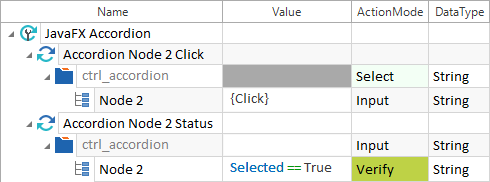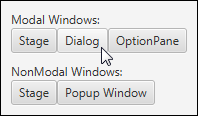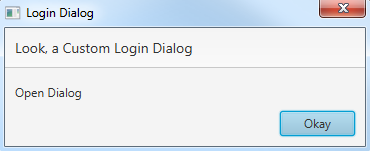Steer JavaFX Controls
JavaFX Modules are created by using Tosca XScan.
Right-click on a Module folder or use the dynamic menu Modules in Tosca Commander and select ![]() Scan -> Application. For further details on how to proceed, see also chapter "Scan Modules".The following standard controls are steered as described in chapter "Steering Controls".
Scan -> Application. For further details on how to proceed, see also chapter "Scan Modules".The following standard controls are steered as described in chapter "Steering Controls".
This chapter contains a detailed description of JavaFX specific controls.

|
Controls that are located beyond the visible area of your test application can be scanned and steered, provided that they are positioned within scroll bars (ScollPanes). The system focuses automatically the area which holds the respective control. |
Accordion
Accordion controls are steered in multiline view as described in chapter "TabControl".

|
In the example below, the tab Node 2 is clicked in the accordion ctrl_accordion. The second TestStep verifies whether the tab Node 2 is expanded.
Accordion: clicking on tabs and verifying the status |
Editable ComboBox
Editable ComboBoxes are ComboBoxes that allow any number of entries to be added.
If you want to steer editable ComboBoxes with Tosca, ensure that the BusinessType of the control is defined as EditableComboBox.

|
In the example below, the value Testvalue is written to an editable ComboBox.
Test application - Editable ComboBox
ComboEditBox - Inputting Testvalue |
Hyperlink
Hyperlinks are steered as described in chapter "Link".
Use the property Visited to verify whether a hyperlink has already been opened.

|
This example verifies whether a hyperlink has not yet been clicked in the test application: Visited = False
Verifying the Visited state of a hyperlink |
ListView
ListView controls are steered as described in chapter "Listbox". Whenever ListView entries that are located outside the visible area are either scanned or steered, the system automatically scrolls to the required cell.

|
In the example below, the system selects the entry Julia from the ListView IvTestListView:
Selecting a ListView entry In the following example, the system verifies whether the entry Matthew exists in the ListView IvTestListView:
Selecting a ListView entry |
Modal and Pop-up windows
Steering modal or popup windows requires that you scan separate Modules for each window.
If modal or popup windows are opened via buttons in the test application, you have to scan a Module that steers the button, and a Module that handles the appearing modal/popup window. We recommend using the click operation {CLICK} to open modal/popup windows.

|
This example steers a modal window in the test application: The Dialog button is clicked, and then the Login Dialog opens.
Opening a modal window
Modal window - Login Dialog The Login Dialog is closed with a click onto the Okay button.
Opening and closing a modal window |
Progress Bar/Indicator
Progress bars or progress indicators can be scanned and steered with Tosca XScan. Use the property Indeterminate to verify, whether a progress bar or progress indicator has no value (=True).
The following ActionModes can be used:
|
ActionMode |
Value (example) |
Description |
|---|---|---|
|
Verify |
50 |
This verifies the status of the progress. |
|
WaitOn |
100 |
The system waits until a specific value has been reached. |

|
This example verifies whether the status of the progress bar shows 10:
Verifying the progress status In the example below, the engine waits until the value of the ProgressBar shows 100 before it continues with the test execution:
Engine waits until the progress bar shows 100% |
TabControl
TabControls can be scanned with Tosca XScan. They are steered as described in chapter "Listbox".
Use TabItems to select individual tabs of a TabControl. To create a TabItem, right-click on a TabControl and choose Create Generic TabItem (see chapter "Generic list items").

|
In this example, the engine selects the Tables tab from the TabControl TabPane1:
TabControl: selecting a tab In the example below, the engine verifies whether the Labels tab is visible (Visible = True) in the test application:
TabControl: verifying a tab |
Toggle Button
Toggle buttons are steered as described in chapter "Button".
Use the property Selected to verify the status of a ToggleButton.

|
In this example, the engine verifies whether the ToggleButton SingleToggleButton is selected in the test application:
Verifying the Selected status of a ToggleButton |
ToolBar
Controls that are located in a toolbar can be scanned and steered in Tosca.
For further information on how to steer various control types, see also chapter "Control types".
Tri-state CheckBox
Tri-state checkboxes can have the status True and False, but also the Indeterminate status.
|
ActionMode |
Value |
Description |
|---|---|---|
|
Input |
True, False, Indeterminate |
Selecting or deselecting a checkbox, or defining the indeterminate status. |
|
Verify |
True, False, Indeterminate <property> |
Verifying a value or a property |
|
Buffer |
<buffer name> |
The value True, False or Indeterminate is buffered, depending on whether the checkbox is selected, deselected, or if its status is indeterminate. |

|
In this example the system verifies whether the status of the Tri-state CheckBox called CheckBox is set to Indeterminate.
Tri-state Checkbox - Status Indeterminate
Verifying the Tri-state CheckBox |
Closing the Java security message
Upon starting a Java application, Java Runtime Environment can open a security message depending on your security settings. You can close this message in Tosca as described in chapter "Close the Java security message".















